Reserve Bank of Australia Annual Report – 1989 Financial Markets and the Bank's Operations[1]
The main policy aim of the Bank's domestic market operations in 1988/89 was to tighten financial conditions to restrain domestic spending. They, together with the Bank's foreign exchange operations, were also concerned day to day with maintaining the stable and smooth operation of the financial system.
In Australia's deregulated financial system, the Bank's domestic operations act in the first instance on interest rates and yields in money and securities markets. These, in turn, affect interest rates of intermediaries and, with a further lag, community decisions to spend and save.
Tightening of financial conditions by the Bank began in April 1988, and continued throughout most of 1988/89. Money market interest rates rose steeply, particularly in October/November 1988, February/March 1989, and in May 1989. Intermediaries' interest rates rose more steadily but in some areas, particularly lending for owner-occupied housing, response to the general rise in rates in the first half of 1988/89 was slow.
Until February 1989, higher interest rates and yields in domestic markets were reflected in a strengthening of the Australian dollar. Continued high commodity prices added to the currency's rise. The Bank, while conscious of the erosion of competitiveness of Australian producers as the dollar rose, placed greater emphasis on maintaining firm domestic monetary conditions than on standing against the rise in the currency.
Reassessment of economic prospects and resulting market uncertainty, after disappointing news about inflation and the current account deficit in early 1989, led to a sharp fall in the dollar in February. The Bank saw advantage in the breaking of the close nexus between high interest rates and a rising currency. Initially it aided the currency's depreciation through sales of Australian dollars in the market. Thereafter, it intervened on a number of occasions on either side of the market to ensure that the fall in the exchange rate, while sustained, was not amplified unduly by market uncertainty.
12 INTEREST RATES AND EXCHANGE RATES
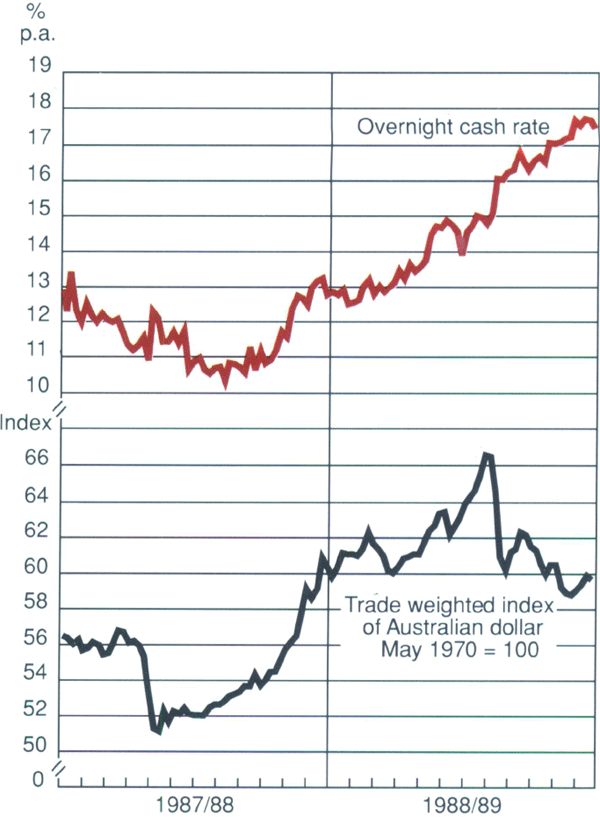
The dollar fell further in May against the strengthening U.S. currency, but rose against other major currencies. Actual and expected changes in interest rates continued to be important for movements in the Australian dollar around its new average level. At the end of the year, the currency was some 12 per cent lower on a trade-weighted basis than its peak in February, but little changed from a year earlier.
The Bank's operations
It is possible to identify four phases in domestic financial markets in 1988/89:
- from July to October, financial markets continued to adjust slowly to the tightening of monetary policy in the preceding quarter. The Bank held money market interest rates broadly steady at the higher levels reached in April, although some short-term security yields increased further. Intermediaries' interest rates rose, catching up to money and securities markets;
- monetary policy was tightened further in October and November; short-term interest rates rose by about 1½ percentage points. Longer-term bond yields also rose, as did intermediaries' rates of interest, responding to the higher short-term rates. Conditions were maintained broadly at this setting until late January;
- at end January, a higher-than-expected figure for the consumer price index triggered a further rise in security yields; they rose again when the current account deficit for January, published in mid February, proved to be very large. The Bank further tightened conditions in money markets, and intermediaries' interest rates followed; banks' indicator lending interest rates rose to about 18¾ per cent and housing loan interest rates to 16 per cent per annum;
- after February, there were seasonal fluctuations in market liquidity, which the Bank had foreshadowed it would seek to smooth. In addition, there were times, particularly in April, when markets exhibited unexpected bullishness. The Bank's operations then aimed to discourage a tendency for interest rates to fall. Monetary policy was tightened further in May, after national accounts and other figures confirmed fears about the persistent strength of private demand. Intermediaries' interest rates continued to rise in May and June, mostly by a further percentage point, catching up with money market conditions.
13 BANK LENDING INTEREST RATES
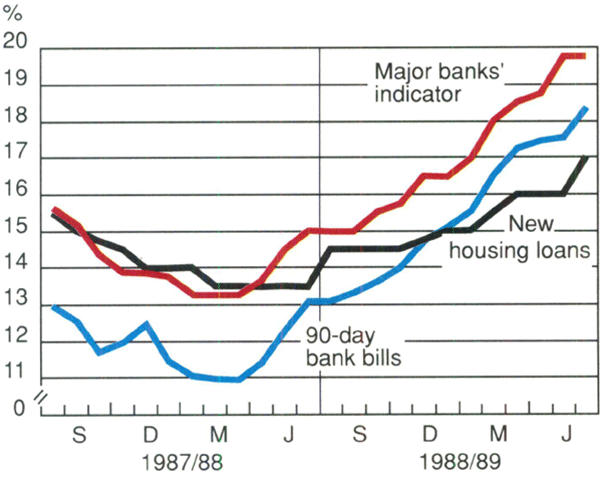
Between March 1988, before monetary conditions began to tighten noticeably, and June 1989, short-term interest rates rose by about 6½ percentage points. The yield curve became sharply inverse; yields on 10-year bonds rose by less than 2 percentage points over the same period. The rises in intermediaries' interest rates varied: banks' indicator lending rates for corporate customers increased by about the same amount as money market rates, while housing loan rates for owner-occupiers rose by 3½ percentage points.
Interest rates on housing loans tend to fluctuate less than other interest rates. Two factors added to the slow response of housing interest rates in the past year:
- a slow shift of deposits from banks' low-interest accounts, which restrained the rise of banks' average costs of funds. This was evidence of continued preference by depositors for high security for their funds; and
- competition among banks for housing business, partly in response to the favourable risk weighting of loans for housing in the assessment of banks' capital adequacy under the Basle formula. The margin required for capital purposes on a housing loan is around half that required on most other commercial loans.
In the foreign exchange market, the Australian dollar strengthened from July 1988 to February 1989, encouraged by rising domestic interest rates and by the continued high levels of commodity prices. The Bank sold Australian dollars at times to test the strength of demand for the currency but did not strongly resist its rise in this period of progressively tighter domestic financial conditions.
Market participants became uncertain about the future direction of the currency after publication of the consumer price index figure at end January. The Bank took the opportunity to sell Australian dollars, converting the uncertainty into a tendency for the currency to decline. Subsequently, there was a sharper depreciation following a disappointing outcome for the current account deficit for January and reports of a series of Ministerial comments.
The dollar was relatively steady on a trade-weighted basis for the remainder of the year. Against the U.S. dollar, which strengthened sharply against other currencies in May, the exchange rate fell; it rose against other major currencies. The Bank's operations over this period were aimed at ensuring that conditions remained orderly and that movements in the Australian dollar were well based.
Over the course of 1988/89, the Bank's transactions in the foreign exchange market aggregated to net purchases of foreign currency (sales of Australian dollars) equivalent to $5½ billion. The impact on international reserves was negligible since it also sold a similar amount directly to customers, mainly the Commonwealth Government. The Government's repayment of overseas debt in 1988/89 added considerably to its foreign exchange requirements.
In its foreign exchange operations, the Bank endeavours as far as possible to prevent settlement of its foreign currency purchases or sales cutting across monetary policy objectives. Where appropriate, it arranges, through swaps or other transactions, settlement of its foreign exchange dealings to accord with the expected cash position of the domestic money market. For instance, settlement of some market purchases of foreign exchange in the earlier months of 1989 was shifted into the June quarter to help offset the liquidity effects of large tax payments at that time.
The Bank is responsible for authorising, and overseeing the activities of, dealers in foreign exchange. It consults with dealers about their activities in the market and on aspects of their internal control systems such as open foreign currency positions. Changes in the way in which net open positions are measured were foreshadowed towards the end of the year and have since been implemented. In keeping in touch with market developments and practices, the Bank is assisted by its participation in the Foreign Exchange Market Consultative Group which includes representatives from both the dealing and broking communities.
14 FOREIGN EXCHANGE MARKET
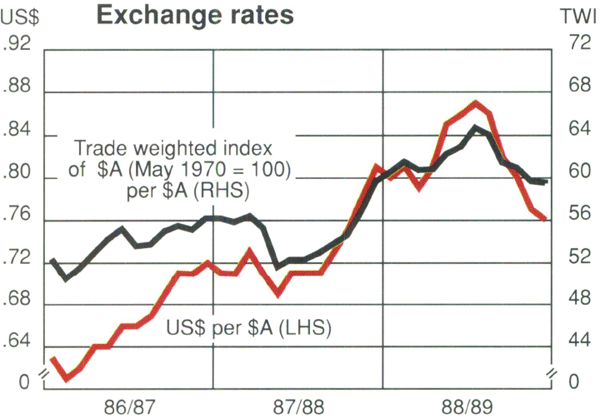
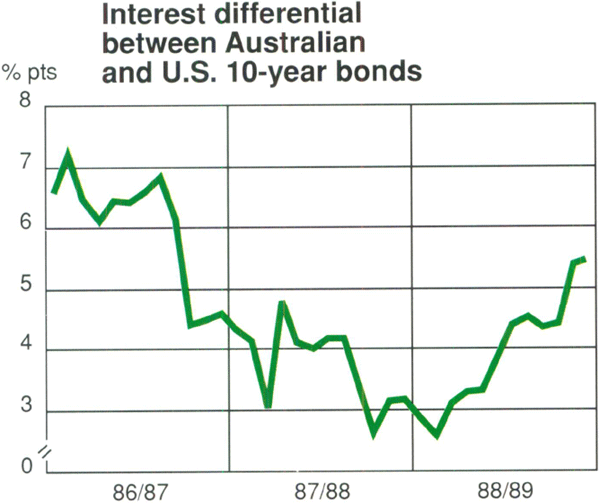
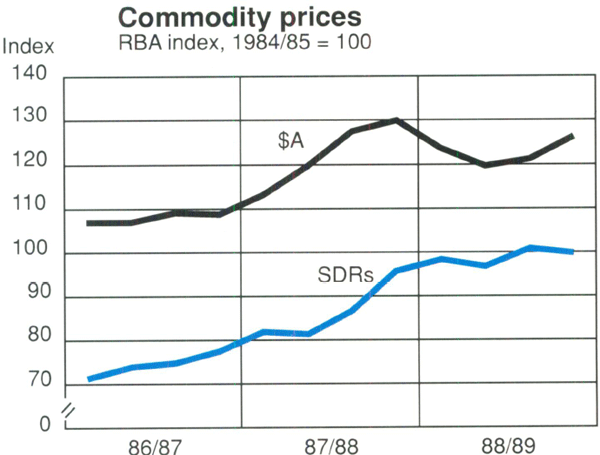
Financing
Credit extended to the private sector by all intermediaries grew by 21 per cent in the year to June 1989. This was not as rapid as the 25 per cent rise in the previous year. The relatively strong credit growth in recent years, and the concomitant rise in debt of the corporate sector in particular, owed much to growing recognition of the favourable effects of the tax deductibility of interest payments on debt when the rate of inflation is high.
The slower growth of credit in 1988/89 was reflected mainly in finance to business. This was despite a buoyant economy. In part, it would have been due to increases in the cost of credit as monetary policy tightened; greater caution about gearing in the wake of the share-market crash of 1987, and high corporate profits as a source of funds for investment, would also have been important factors. The slowing in credit growth has come earlier in the cycle than has been typical in the past. The corporate sector, nevertheless, remains highly geared by historical standards.
15 FINANCING
6-month-ended growth at an annual rate
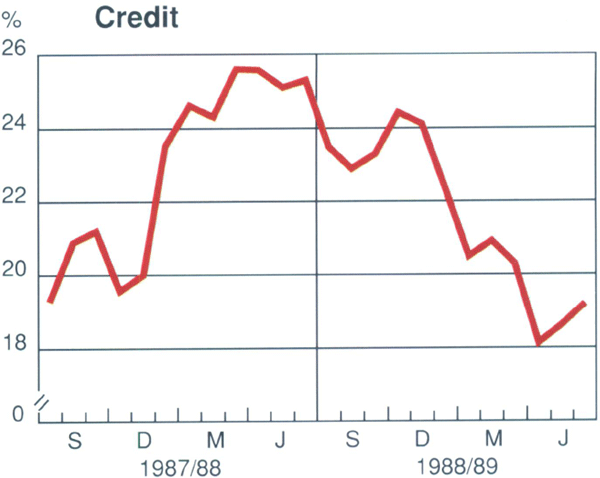
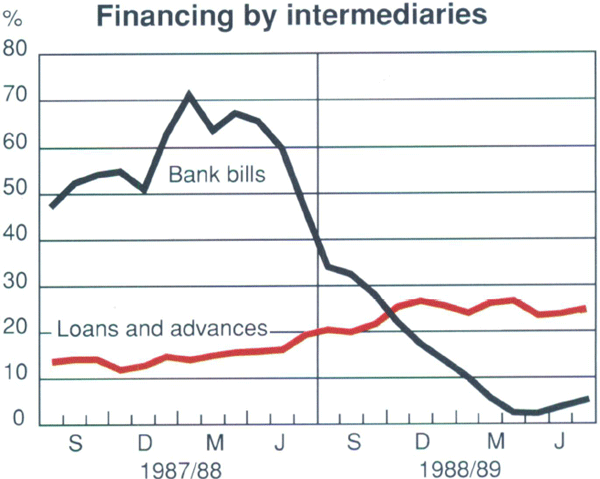
Lending for housing, both for owner occupation and investment, made a substantial call on credit growth throughout the year. Intermediaries competed strongly to expand housing lending and demand appeared to be little dented by the slow rise of mortgage interest rates in 1988 (discussed above), although there was a sharp fall in loan approvals in June after housing interest rates rose to 17 per cent per annum. Loan approvals for investment housing were buoyant for much of the year; reintroduction (in July 1987) of tax deductibility for interest payments in excess of rental income for investors, together with the expectation earlier in the year of substantial capital gains as home prices boomed, added to the strength of demand for loans.
16 SHARE MARKET
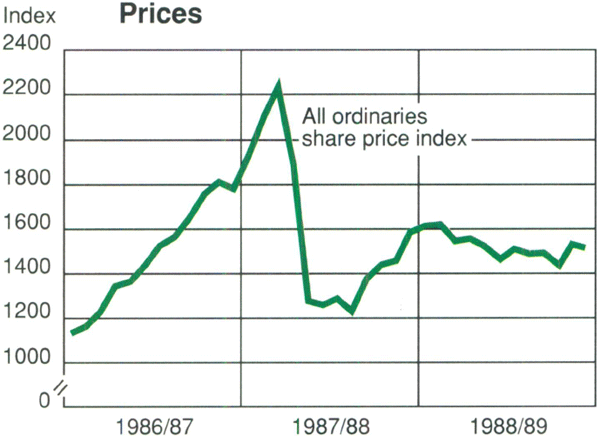
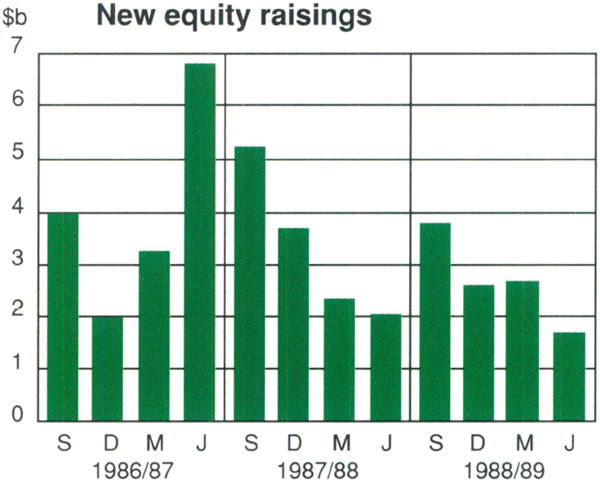
17 DEPOSITS OF INTERMEDIARY GROUPS
3-month-ended growth at an annual rate
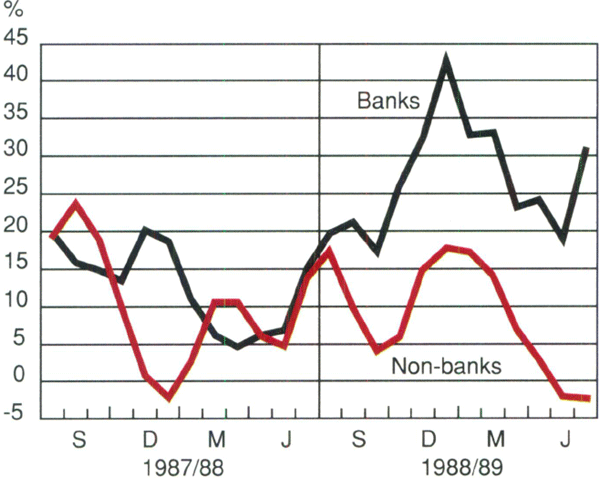
18 MONETARY AGGREGATES
3-month-ended growth at an annual rate
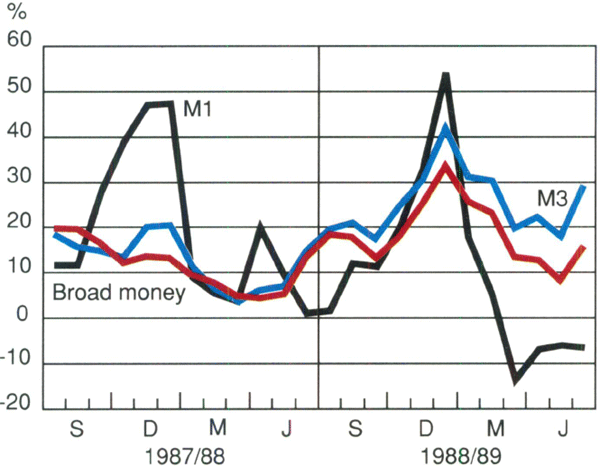
Lending to households for purposes other than housing was also strong, with finance for motor vehicle purchases a major factor.
Direct financing by companies (by issues of equities, promissory notes and corporate bonds), was subdued during 1988/89, as it had been since the share-market crash of October 1987. Much of the equity issued by companies represented automatic reinvestment of dividend payments, which have increased since the introduction of tax imputation. There were sizeable issues of corporate bonds early in the year, especially by intermediaries, but issues were fewer as interest rates continued to rise later in the year.
Removal of the Statutory Reserve Deposit (SRD) requirement for trading banks (see page 31) had a major impact on banks' balance sheets. The bulk of this impact was felt in the last three months of 1988. Bank lending grew more quickly, while growth of bank bills declined. Domestic deposits, including certificates of deposit, grew strongly to fund banks' increased lending and to replace some offshore borrowing. Broader measures of intermediaries' liabilities, which include both deposits and other sources of funds, and which had been growing much more quickly than deposits before the removal of the SRD, grew at a steady pace over this period.
Government securities market
The Bank's domestic market operations are conducted in Commonwealth Government securities, or repurchase agreements involving Commonwealth Government securities. The supply of these securities fell in 1988/89, as in the previous year, reflecting the Commonwealth budget surplus. The stock outstanding of domestically-issued Commonwealth Government securities fell by about $2¾ billion. Within this, Treasury bonds fell by $3½ billion, Australian Savings Bonds fell by $¾ billion, and Treasury notes rose by $1¾ billion.
A large part of the available Commonwealth Government securities is held by banks as the major component of their Prime Assets Ratio (PAR) requirement. The PAR requirement was reduced in September 1988 (see page 33); however, the impact of this on banks' holdings of prime assets was largely offset by the rapid growth of their balance sheets.
The fall in the stock of Commonwealth Government securities in 1988/89 was concentrated in the June quarter when the proceeds from maturities of Treasury notes and bonds were used by the financial system to fund transfers to the Government caused by seasonally large tax payments. The PAR requirement meant that banks would have been unable to reduce substantially their holdings without also reducing the sizes of their balance sheets. The bulk of the fall was met, therefore, from non-bank portfolios, facilitated by development of the market in repurchase agreements. As usual, the gap between yields on Commonwealth Government securities and those on private paper widened as the tax collection period approached. At times it was up to 2 percentage points, as wide as it had been a year earlier. This reflected the strong demand by banks for Commonwealth paper.
Turnover in the Commonwealth bond market declined from around $1½ billion per day in 1987/88 to around $1¼ billion per day in 1988/89. Contributing factors were the smaller volume of new bonds issued — a large proportion of turnover is the “bedding down” of newly-issued securities by the professional traders who purchase them at tender — and the reluctance of some holders to give up securities which would have to be replaced in the future to preserve asset ratios.
The Commonwealth Government undertook in 1988/89 a programme of debt consolidation. This was intended to enhance the liquidity of the Commonwealth debt on issue by removing less popular stocks with small quantities outstanding and replacing them with more heavily traded series. The operation had no effect on the total stock of securities outstanding. Other things being equal, a programme of this nature may be expected to reduce the overall cost of servicing debt. An additional $2 billion of the more popular stocks were issued and the Bank purchased in the market an equivalent amount of less popular stocks, which were subsequently cancelled.
19 GOVERNMENT SECURITIES MARKET
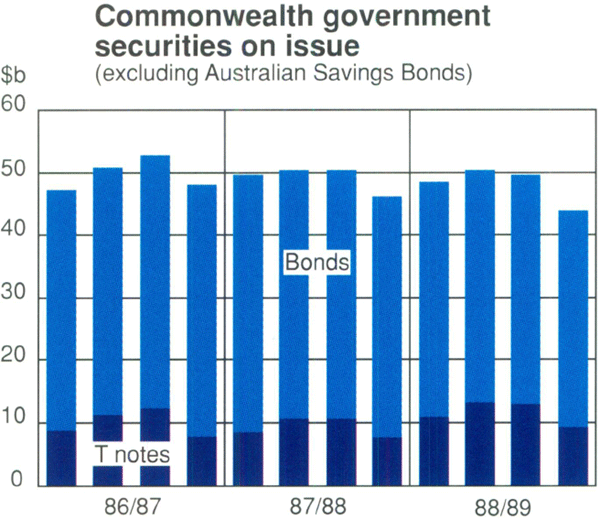
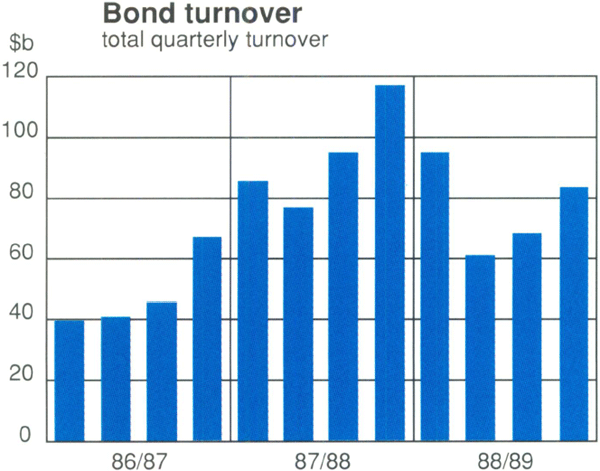
20 TREASURY NOTE AND BOND YIELDS
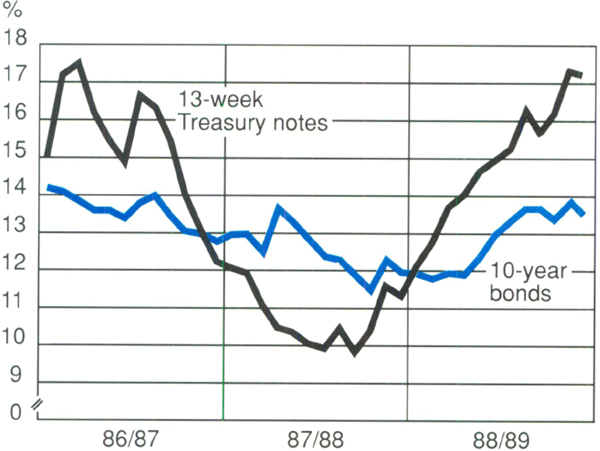
Changes in the Bank's portfolio
The size and composition of the Bank's balance sheet change, often substantially, from week to week. Movements are due to several main factors: the Bank's market operations, which involve the purchase and sale of Commonwealth Government securities and foreign exchange; transactions with the Bank's customers, especially governments; earnings on investments; and fluctuations in the market values of various assets.
In 1988/89, the balance sheet totals fell by $½ billion. The net fall reflected valuation effects, as the Bank's operations in domestic and foreign assets produced little change in the size or composition of its balance sheet. This was in contrast to the previous year, when there was a large increase in the Bank's holdings of foreign exchange and a correspondingly large fall in its holdings of Commonwealth Government securities.
The Bank's holdings of gold and foreign exchange were broadly unchanged at about $20 billion; earnings on foreign currency investments added $1 billion, but these were largely offset by valuation effects. Net purchases of foreign exchange from the market were offset by sales to government.
The Bank's holdings of Commonwealth Government securities fell by $½ billion over the year. Its market purchases and sales of securities were each about $55 billion.
The Bank's domestic market operations in securities reflect many influences. Among these is the increase of the public's holdings of notes and coin; this year the increase in notes and coin on issue was $1¼ billion, somewhat smaller than the increase of $1¾ billion in 1987/88. The Bank would usually be a net buyer of Commonwealth Government securities over a year as a result of this. However, other factors affecting the Bank's operations in securities about offset it this year. Among these was a fall of $½ billion in deposits of other banks with the Reserve Bank because of changes in the SRD system described in the next chapter.
Footnote
*Articles on events in financial markets and the Bank's operations are published regularly in the Bank's Bulletin. [1]